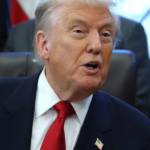President Donald Trump has been back in office long enough for Americans to expect at least glimmers of the economic golden age he promised. Instead, warning signals are flashing.
They’re now coming from voters as well as from the patchy data available during a record-long government shutdown. The economy is expanding, but reliance on the artificial intelligence boom — and the stock-market wealth it’s generated — makes growth look lopsided. Play Video
Democrats trounced Trump’s Republicans last week in elections where cost-of-living anxieties loomed large. Half of the respondents in an October survey by the Harris Poll for Bloomberg News said the economy wasn’t working for them – up from 41% in February – and only one-third said their finances were better than a year ago.
“The economy remains resilient on the surface, but it’s increasingly dependent on three narrow, interconnected ‘A-pillars’: affluent consumers, artificial intelligence-fueled investment and asset price gains,” wrote Gregory Daco, chief economist at EY-Parthenon and president of the National Association for Business Economics. “If any one of these pillars weakens, the overall structure would become much less stable.”
On the growth front, what economists see right now is a slowdown capping Trump’s rollercoaster first year. US gross domestic product shrank at the outset — thanks to a monumental import surge, as firms and consumers rushed to get ahead of tariffs — and then rebounded fast for a while.
What the White House sees is a “gradual transition” underway between the Biden and Trump economies, according to Pierre Yared, acting chair of the Council of Economic Advisers.
“The policies of the president are bearing fruit,” Yared said in a telephone interview. He pointed to three main metrics — overall growth, well-paying jobs, and building secure supply chains in America — as well as US outperformance over peers like the European Union.
Manufacturing in particular, where Trump promised a tariff-led renaissance, has struggled. It’s been in contraction for eight straight months and shed 42,000 jobs since April – the longest losing streak since the pandemic — after the president unveiled his global tariffs.
Yared said what matters is the quality of jobs, and he pointed to a pickup in manufacturing productivity this year, as well as higher inflation-adjusted weekly pay in factories, mining and construction – all priority areas for the administration.
In industries such as manufacturing, construction, agriculture and hospitality, the pool of available labor has shrunk in part because of Trump’s immigration crackdown. After a wave of raids and deportations, monthly border crossings — which surged under Biden — have plummeted close to zero.
Trade has been at the top of Trump’s second-term agenda. The president has followed through on campaign promises to hike import taxes, with the goals of revitalizing manufacturing, erasing deficits with US trading partners, and raising government revenue.
The latter is happening: with US tariffs now their highest in roughly a century, the Treasury Department is collecting around $30 billion a month. Trump also touts the investments in the US that companies and trade partners have pledged as a result of his dealmaking.
But his on-and-off approach to imposing the duties – illustrated again last month when he dialed back charges on Chinese imports – has caused tremendous uncertainty, with many businesses halting investment and hiring decisions until they see where rates settle.
At 3%, the headline inflation rate is roughly where it was when Trump took office, after prices surged a cumulative 20% under Biden in the pandemic aftermath. Business expectations for prices in the year ahead are holding steady, and the worst fears of consumers appear to have eased in recent months.
Trump and Bessent put cheaper energy at the heart of their program. They have cited this year’s drop in gasoline costs, and argued deregulation will lower them further. But the administration’s AI push may inflate electric bills because data centers need vast amounts of power. And while the AI giants enjoy tariff exemptions for key equipment, electricity generators aren’t so favored – raising the risk that capacity will fall behind demand and add to price pressures.
All that new equity wealth has boosted consumer spending, which accounts for about two-thirds of demand in the economy – but also skewed it toward the rich.









